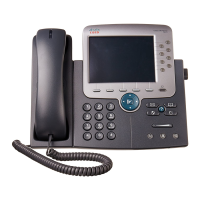9-8
Cisco Unified IP Phone 7975G Administration Guide for Cisco Unified Communications Manager 6.0
OL-12642-01
Chapter 9 Troubleshooting and Maintenance
Troubleshooting Cisco Unified IP Phone Security
Step 2 Modify DHCP and IP settings:
a. Disable DHCP. See the “Network Configuration Menu” section on page 4-5 for instructions.
b. Assign static IP values to the phone. See the “Network Configuration Menu” section on page 4-5
for instructions. Use the same default router setting used for other functioning Cisco Unified IP
Phones.
c. Assign TFTP server. See the “Network Configuration Menu” section on page 4-5 for instructions.
Use the same TFTP server used for other functioning Cisco Unified IP Phones.
Step 3 On the Cisco Unified Communications Manager server, verify that the local host files have the correct
Cisco
Unified Communications Manager server name mapped to the correct IP address.
Step 4 From Cisco Unified Communications Manager, choose System > Server and verify that the server is
referred to by its IP address and not by its DNS name.
Step 5 From Cisco Unified Communications Manager, choose Device > Phone and verify that you have
assigned the correct MAC address to this Cisco
Unified IP Phone. For information about determining a
MAC address, see the
“Determining the MAC Address of a Cisco Unified IP Phone” section on
page 2-13.
Step 6 Power cycle the phone.
Checking Power Connection
In most cases, a phone will restart if it powers up using external power but loses that connection and
switches to PoE. Similarly, a phone may restart if it powers up using PoE and then gets connected to an
external power supply.
Troubleshooting Cisco Unified IP Phone Security
Table 9-1 provides troubleshooting information for the security features on the Cisco Unified IP Phone.
For information relating to the solutions for any of these issues, and for additional troubleshooting
information about security, refer to Cisco Unified
Communications Manager Security Guide.
Table 9-1 Cisco Unified IP Phone Security Troubleshooting
Problem Possible Cause
CTL File Problems
Device authentication error. CTL file does not have a
Cisco
Unified Communications
Manager certificate or has an incorrect
certificate.
Phone cannot authenticate CTL file. The security token that signed the
updated CTL file does not exist in the
CTL file on the phone.
Phone cannot authenticate any of the
configuration files other than the CTL
file.
Bad TFTP record.

